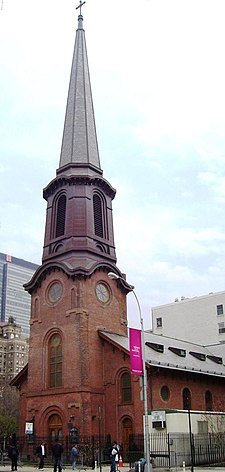Church of the Holy Apostles (Manhattan)
Church of the Holy Apostles | |
 | |
| Location | 296 Ninth Ave. Manhattan, New York City |
|---|---|
| Built | 1845-48, 1853-54, 1858 |
| Architect | Minard Lafever Charles Babcock |
| Architectural style | Italianate |
| NRHP reference No. | 72000867[1] |
| Significant dates | |
| Added to NRHP | April 26, 1972 |
| Designated NYCL | October 19, 1966 |
The Church of the Holy Apostles is an Episcopal parish located at 296 Ninth Avenue at 28th Street in the Chelsea neighborhood of Manhattan, New York City. Its historic church building was built from 1845 to 1848,[2] and was designed by the noted New York architect Minard Lafever.[3] The geometric stained-glass windows were designed by William Jay Bolton.[4] The building is a New York City landmark and on the National Register of Historic Places.
History
The Holy Apostles congregation "was founded in 1844 as the result of an outreach by Trinity Church to immigrants who worked on the Hudson River waterfront to the west of the Church’s location in the Chelsea section of Manhattan",[5] evolving out of a Sunday school.[4] Construction on the sanctuary began in 1845 and continued through 1848, although Lafever enlarged the building by 25 feet by adding a chancel in 1853-54.[2] In 1858 the congregation needed to expand, so architect Charles Babcock of the firm of Richard Upjohn & Son enlarged the building into a cross-shaped sanctuary with the addition of transepts.[2]
The church, the only one that Lafever designed which remains extant in New York City, is also one of the very few there of Italianate design,[2] although the church has also been described as an early example of Romanesque Revival architecture.[6] The vestry is in "pure Tusan" style.[7] Lafever's sanctuary was a three-aisled basilica. The ceiling was vaulted with plaster groins "small in scale but beautiful in proportion." Original Lafever touches in the details include the corbels from which the ribs spring.[7]
The church's congregation has always been a socially active one. It is rumored that the church was a stop on the Underground Railroad during the American Civil War.[4] In the 1970s, the church was instrumental in the foundation of Congregation Beit Simchat Torah, a synagogue for gays and lesbians begun by Jacob Gubbay. It hosted the congregation until it found a permanent home, and the synagogue's Friday services are still held at Holy Apostles.[4] In that same decade, Holy Apostles hosted the ordination of the first woman minister in the New York diocese, Rev. Ellen Barrett.[4] In 1982, the congregation began the Holy Apostles Soup Kitchen, which continues to serve the indigent of the area.
The sanctuary was badly damaged in 1990 by a fire, in which some of the stained-glass windows were lost,[6] but most survived without serious damage.[2][4] A restoration began almost immediately, and was completed in 1994 under the supervision of Ed Kamper, without interruption of the social services the church provides.[2][4]
The Church of the Holy Apostles was designated a New York City landmark in 1966, and was added to the National Register of Historic Places in 1972.
References
- ^ "National Register Information System". National Register of Historic Places. National Park Service. March 13, 2009.
- ^ a b c d e f New York City Landmarks Preservation Commission; Dolkart, Andrew S.; Postal, Matthew A. (2009). Postal, Matthew A. (ed.). Guide to New York City Landmarks (4th ed.). New York: John Wiley & Sons. ISBN 978-0-470-28963-1., p.72
- ^ The tower is Plate 7 in Lafever's book, Complete Architectural Instructor.
- ^ a b c d e f g Dunlap, David W. (2004). From Abyssinian to Zion: A Guide to Manhattan's Houses of Worship. New York: Columbia University Press. ISBN 0-231-12543-7., pp.98-99
- ^ Church of the Holy Apostles website
- ^ a b White, Norval & Willensky, Elliot (2000). AIA Guide to New York City (4th ed.). New York: Three Rivers Press. ISBN 978-0-8129-3107-5., pp. 188-189
- ^ a b Hamlin, Talbot. "The Rise of Eclecticism in New York", Journal of the Society of Architectural Historians, Vol. 11, No. 2 (May, 1952), pp. 3-8
External links
- Church website
 Media related to Church of the Holy Apostles (Manhattan) at Wikimedia Commons
Media related to Church of the Holy Apostles (Manhattan) at Wikimedia Commons
- Churches in Manhattan
- Properties of religious function on the National Register of Historic Places in Manhattan
- Episcopal churches in New York
- Italianate architecture in New York
- Churches completed in 1846
- 19th-century Episcopal churches
- Romanesque Revival churches in New York
- Churches on the Underground Railroad
- Chelsea, Manhattan



